A) Squamous suture
B) Styloid process of temporal
C) Lambdoidal suture
D) Maxilla
E) External auditory meatus
F) Frontal
G) Coronal suture
H) Occipital
I) Parietal
J) Orbit
K) Nasal
L) Ramus
M) Temporal
N) Sphenoid
O) Malar (zygomatic)
P) Lacrimal
Q) Mandible
R) Ethmoid
Correct Answer

verified
Correct Answer
verified
Multiple Choice
The _______ is/are not part of the appendicular skeleton.
A) bones of the upper extremities
B) sacrum
C) scapula
D) pelvic girdle
Correct Answer

verified
Correct Answer
verified
Multiple Choice
Fill in the correct labels for the following figure using the word bank below.
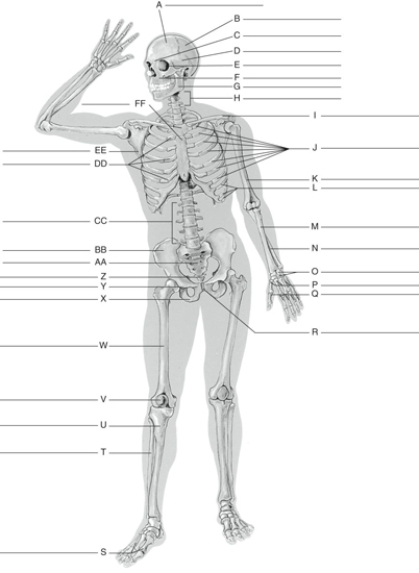 -CC ___________
-CC ___________
A) Ilium
B) Costal cartilages
C) Scapula
D) Sacrum
E) Lumbar vertebrae
F) Sternum
Correct Answer

verified
E
Correct Answer
verified
Multiple Choice
Fill in the correct labels for the following figure using the word bank below.
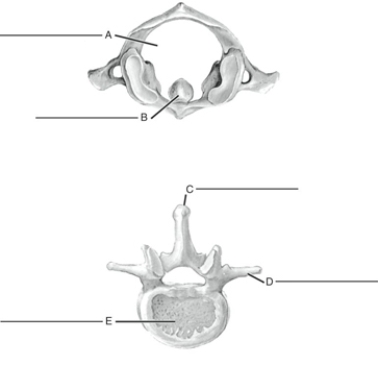 -B __________
-B __________
A) Transverse process
B) Spine
C) Centrum (body)
D) Vertebral foramen
E) Odontoid process of axis
Correct Answer

verified
E
Correct Answer
verified
Multiple Choice
The marrow cavity of a long bone is lined with a thin layer of cells called the _______.
A) periosteum
B) hyaline
C) endosteum
D) osteon
Correct Answer

verified
Correct Answer
verified
Multiple Choice
Fill in the correct labels for the following figure using the word bank below.
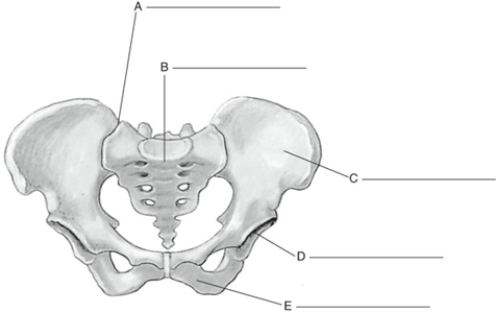 -A ___________
-A ___________
A) Acetabulum
B) Sacroiliac joint
C) Pubis
D) Ilium
E) Sacrum
Correct Answer

verified
Correct Answer
verified
Multiple Choice
Fill in the correct labels for the following figure using the word bank below.
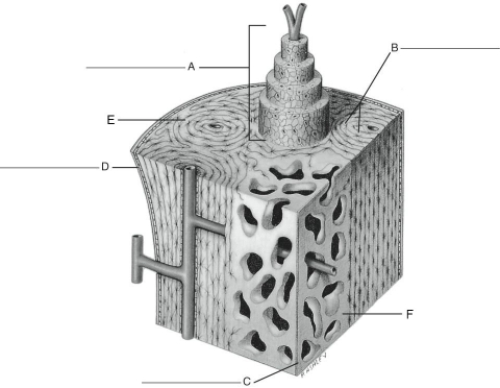 -A ___________
-A ___________
A) Endosteum
B) Compact Bone
C) Spongy Bone
D) Lacunae containing osteocytes
E) Haversian system
F) Fibrous layer of periosteum
Correct Answer

verified
Correct Answer
verified
Multiple Choice
Osteoclasts are cells that _______.
A) break down bone
B) secrete the protein collagen
C) are modeled during growth
D) produce bone
Correct Answer

verified
Correct Answer
verified
Multiple Choice
Fill in the correct labels for the following figure using the word bank below.
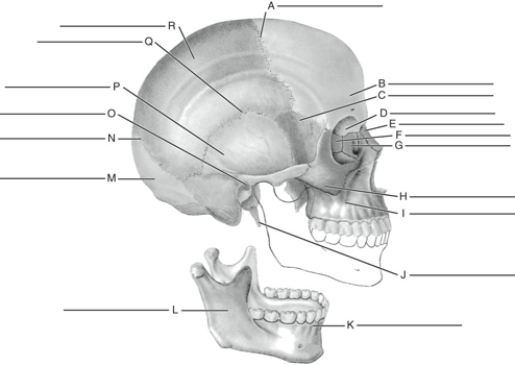 -D ___________
-D ___________
A) Squamous suture
B) Styloid process of temporal
C) Lambdoidal suture
D) Maxilla
E) External auditory meatus
F) Frontal
G) Coronal suture
H) Occipital
I) Parietal
J) Orbit
K) Nasal
L) Ramus
M) Temporal
N) Sphenoid
O) Malar (zygomatic)
P) Lacrimal
Q) Mandible
R) Ethmoid
Correct Answer

verified
Correct Answer
verified
Multiple Choice
Bones are held together at joints by bands of connective tissue called _______.
A) ligaments
B) tendons
C) marrow
D) fasciae
Correct Answer

verified
Correct Answer
verified
Multiple Choice
Fill in the correct labels for the following figure using the word bank below.
 -AA ___________
-AA ___________
A) Ilium
B) Costal cartilages
C) Scapula
D) Sacrum
E) Lumbar vertebrae
F) Sternum
Correct Answer

verified
Correct Answer
verified
Multiple Choice
Fill in the correct labels for the following figure using the word bank below.
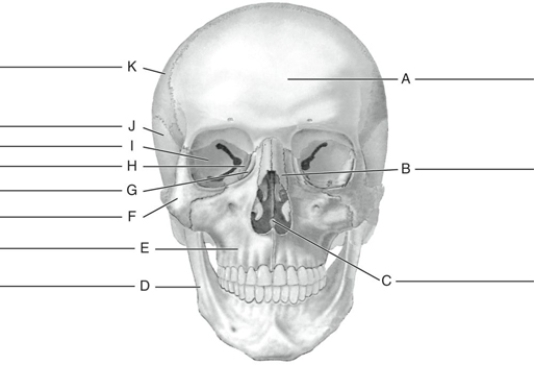 -I ___________
-I ___________
A) Vomer
B) Malar (zygomatic)
C) Temporal
D) Frontal
E) Sphenoid
F) Parietal
G) Mandible
H) Maxilla
I) Nasal
J) Lacrimal
K) Ethmoid
Correct Answer

verified
Correct Answer
verified
Multiple Choice
Fill in the correct labels for the following figure using the word bank below.
 -F ___________
-F ___________
A) Endosteum
B) Compact Bone
C) Spongy Bone
D) Lacunae containing osteocytes
E) Haversian system
F) Fibrous layer of periosteum
Correct Answer

verified
Correct Answer
verified
Multiple Choice
The sagittal suture _______.
A) is the joint between the two parietal bones
B) joins the parietal bone to the occipital bone
C) joins the parietal bones to the frontal bone
D) permits a baby's head to be compressed during birth
Correct Answer

verified
Correct Answer
verified
Multiple Choice
Bones serve as levers that transmit _______ forces.
A) skeletal
B) neuromuscular
C) muscular
D) neural
Correct Answer

verified
Correct Answer
verified
Multiple Choice
Fill in the correct labels for the following figure using the word bank below.
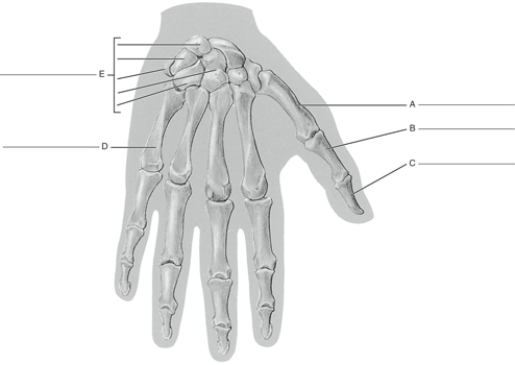 -B ___________
-B ___________
A) Distal phalanx
B) Carpals
C) Metacarpal
D) Proximal phalanx
E) metacarpal
Correct Answer

verified
Correct Answer
verified
Multiple Choice
_______ are joints that do not permit movement.
A) Amphiarthroses
B) Diarthroses
C) Synarthroses
D) Synovial
Correct Answer

verified
Correct Answer
verified
Multiple Choice
Fill in the correct labels for the following figure using the word bank below.
 -D ___________
-D ___________
A) Distal phalanx
B) Carpals
C) Metacarpal
D) Proximal phalanx
E) metacarpal
Correct Answer

verified
E
Correct Answer
verified
Multiple Choice
Fill in the correct labels for the following figure using the word bank below.
 -J ___________
-J ___________
A) Squamous suture
B) Styloid process of temporal
C) Lambdoidal suture
D) Maxilla
E) External auditory meatus
F) Frontal
G) Coronal suture
H) Occipital
I) Parietal
J) Orbit
K) Nasal
L) Ramus
M) Temporal
N) Sphenoid
O) Malar (zygomatic)
P) Lacrimal
Q) Mandible
R) Ethmoid
Correct Answer

verified
Correct Answer
verified
Multiple Choice
If we compare the upper and lower limbs, _______.
A) the humerus corresponds to the tibia
B) each has 28 phalanges
C) the 15 metacarpal bones correspond to the 15 metatarsal bones
D) the 16 carpal bones correspond to the 16 tarsal bones
Correct Answer

verified
Correct Answer
verified
Showing 1 - 20 of 114
Related Exams